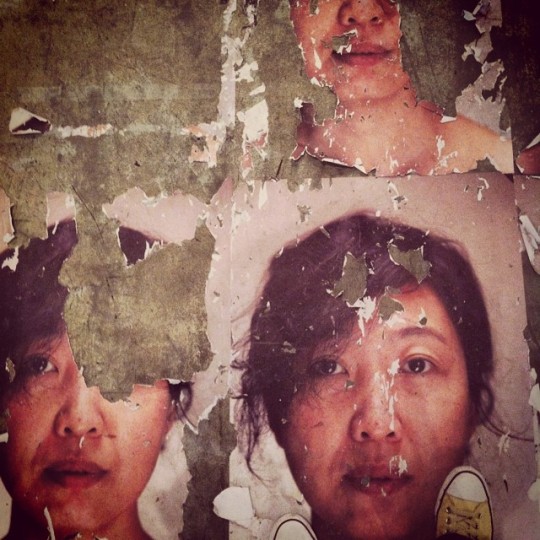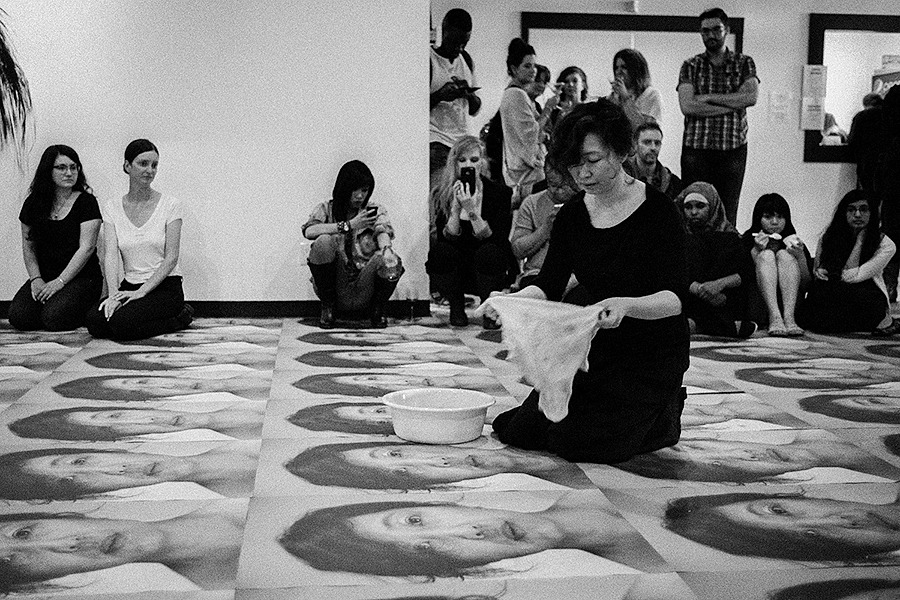Insoon Ha | Monology and Face
June 19 – July 26, 2014
Opening reception and performance | Thursday, June 19 at 7 pm
Insoon Ha’s print and photographic installation delves into violence and post-colonial stasis through minimal forms. Ha’s confused identities are created in “Monology” as hybrid woman-animal forms and everyday objects apparently repurposed for torture—and by forcing viewers to walk directly on her self-portraits, damaging them as well as offering a kind of insult to the artist, in “Face”. In live performance, Insoon Ha will place this dirty process directly on herself, washing her face in dirty water mopped from the installation floor.
Monology
When I was approached to write an essay about Insoon Ha’s upcoming exhibition, it was as “someone who can speak about an experience of Asian women’s identities here”. I was intrigued: while there are some equivalencies, the category “Asian Canadian” glosses over some very important distinctions. “Asian Canadian” is more about how we are perceived from the outside and how that superficial perception affects how we are treated in a Canadian context.
I am Canadian-born of Japanese immigrant parents who came to Canada in the late ‘60s. Insoon Ha is a first-generation immigrant from Korea, arriving here about 11 years ago. Different geography, different history, different personal history. This complicates the “Asian Canadian experience”, to say the least.
Ha’s exhibition includes a series of photographic works depicting women, animals, and everyday objects repurposed as instruments of torture (Monology) and an installation/performance called Face. The latter is a room full of large digital self-portraits installed on the floor. The audience walks on her face, and at the end of the run, the artist washes the floor, then uses the water to wash her face. Monology and Face make reference to gender, violence and trauma, especially the violence inflicted upon Korea during the Japanese forced occupation, and more specifically against Korean comfort women—a euphemism for women who were forced into prostitution by the Japanese military.
Face is a heartbreaking piece. It’s not easy watching someone suffer, and especially if it’s suffering at her own hands, by the meta-artist who planned and created the work, as well as as the performer who brings it upon herself (an internalized victimization?)—and our own complicity.
“I heard about comfort women when I was young. Now I know my country’s history and I know that I can also be the victimizer,” says Ms. Ha, referring to Korea’s use of comfort women in Vietnam. Her work, which she calls “something very simple”, elicits a strong reaction from visitors who might be more comfortable intellectualizing the horrors of sexual violence. “It’s kind of a role play. It’s two parts: victim and victimizer. People who step on my face, they become the victimizer. We can make them feel very uncomfortable with that situation, and I push them.”
It’s easy to feel bad about victims, and condemn victimizers. But when one digs deeper, it becomes unclear who did what to whom, and what the effects are. Insoon’s country suffered greatly at the hands of the nation of my ancestors. But Canada, for her, is a place where she is free(er) to make her art. She claims to have never experienced discrimination in Canada. I lived through the Gung Ho/Rising Sun/Mr. Baseball era of 1980s anti-Japanese sentiment. That was a lousy time to be Asian in North America, let me tell you. On the other hand, it was also the time where the Japanese Redress movement in Canada received an apology and a cash settlement. My family was never interned, though, so that led to some awkward conversations in Social Studies class. Oppression, especially in Canada, is extremely uneven.
This brings us to privilege, of course: why are people so resistant to acknowledging their own? Acknowledging your privilege is the other side of empathy, isn’t it? That we all suffer, more or less than others, and sometimes in ways we don’t understand. And knowing that makes each of us more aware of the potential to also be abused, or be an abuser. Ha believes it’s important to know trauma—your own, and others’—and to relive these experiences, no matter how unpleasant. “I think it’s funny that people have a hard time seeing the trouble, the pain. People want to cure the trauma, but it doesn’t go away.”
It’s a nice thing to do. But even more so, there is danger in not doing so. In her artist statement, she writes: “We all believe we have been hurt and thus can empathize/sympathize with the plight of victims. But when we cloak ourselves in the banner of ‘the good’, ‘the just’ or ‘the right’ we become blind to the realities of the pain and suffering we inflict on others.”
It could be you. It could be me.
-
Mari Sasano has worked as a freelance writer for 15 years.
She wrote for the Edmonton Journal for many years, and has also contributed articles and short fiction to magazines such as Broken Pencil, RicePaper, and Alberta Views. She is currently employed at Recoil Creative Media as a writer and researcher. Mari has also worked as a communications person for a number of arts organizations, written a children’s play, and taught writing at a university. She is occasionally called upon to contribute to the Pop Culture panel on the television show, Alberta Primetime.
Mari is also the administrator and co-curator of Prairie Tales, a compilation of short Alberta films, and the manager of Avenue Goes to the Dogs, a festival for dogs. Mari has also worked as a videographer, sandwich-maker, bass player, secretary, record store clerk, and hair model.
Born in Seoul, Korea, Insoon Ha immigrated to Canada in 2003. She holds both a BFA and MFA from the University of Seoul in Sculpture, and a second MFA from the State University of New York at Buffalo in Fine Arts. She is a multidisciplinary artist who works in sculpture, installation and video. Her work has been exhibited throughout Korea, the United States and Canada at the Museum of Contemporary Canadian Art and A Space Gallery in Toronto, McMaster Museum of Art in Hamilton, Big Orbit Gallery, Albright-Knox Art Museum and Art Space & Hallwalls Contemporary Art Center in Buffalo, “X Industria: CAFKA 05” in Kitchener, 621 Gallery in Tallahassee, FL., Cepa Gallery in Buffalo, NY and LA CENTRALE Gallery Powerhouse in Montreal.




